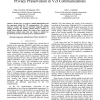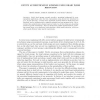1116 search results - page 17 / 224 » Key Agreement Using Statically Keyed Authenticators |
CORR
2004
Springer
13 years 7 months ago
2004
Springer
Chebyshev polynomials have been recently proposed for designing public-key systems. Indeed, they enjoy some nice chaotic properties, which seem to be suitable for use in Cryptogra...
VTC
2010
IEEE
13 years 6 months ago
2010
IEEE
—In this paper, we propose a mutual authentication and key agreement scheme for V2I communications. Our scheme improves security and privacy protection compared with the existing...
CSREASAM
2006
13 years 9 months ago
2006
Group communication is becoming increasingly popular in Internet applications such as videoconferences, online chatting programs, games, and gambling. For secure communications, th...
SCN
2010
Springer
13 years 6 months ago
2010
Springer
We introduce a protocol, that we call Human Key Agreement, that allows pairs of humans to establish a key in a (seemingly hopeless) case where no public-key infrastructure is avail...
DAM
2006
13 years 7 months ago
2006
Abstract. Artin's braid groups currently provide a promising background for cryptographical applications, since the first cryptosystems using braids were introduced in [2, 3, ...


